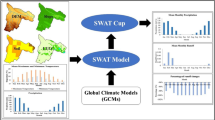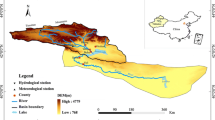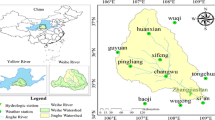Abstract
Runoff is simulated using the Soil and Water Assessment Tool (SWAT) in the Shiyang River Basin and considering the precipitation and temperature obtained from five climate models in the Coupled Model Intercomparison Project Phase 5 (CMIP5), including MRI-CGCM3, CanESM2, CNRM-CM5, GFDL-CM3, and FGOALS-g2. Precipitation and temperature were downscaled as the input for SWAT, and the uncertainty in runoff simulation under climate models was evaluated based on the Bayesian information criterion (BIC) and expectation-maximization (EM) algorithms of Bayesian model average (BMA) method, also runoff variation in the future was predicted. Results showed that, for the downscaled precipitation, the accuracy index R2 are mainly concentrated in 0.42–0.58. For the downscaled temperature, R2 is greater than 0.5. The predicted runoff using BMA is better than that using the single climate model in most sub-basins. MRI-CGCM3 and GFDL-CM3 have larger contribution than other three models using BMA based on either BIC or EM algorithms. Compared to the period of 1990–1999, temperature of each climate model is obviously increasing during 2018–2100. While for precipitation, CNRM-CM5 and FGOALS-g2 showed an increasing trend in all sub-basins. But GFDL-CM3, CanESM2, and MRI-CGCM3 vary across sub-basins. The trend in runoff is consistent with precipitation. To sum up, precipitation, temperature, and runoff under most climate models will increase in the future. The results will provide a reference for the utilization and management of water resources in the future.
Access this chapter
Tax calculation will be finalised at checkout
Purchases are for personal use only
Similar content being viewed by others
References
Abbaspour K (2014) SWAT-CUP 2012: SWAT calibration and uncertainty programs—a user manual. Science And Technology 106:1–10
Abbaspour KC, Vejdani M, Haghighat S (2007) SWAT-CUP calibration and uncertainty programs for SWAT. In: Modsim international congress on modelling & simulation land water & environmental management integrated systems for sustainability vol 364(3), pp 1603–1609
Ajami NK, Duan Q, Gao X (2006) Multimodel combination techniques for analysis of hydrological simulations: Application to distributed model intercomparison project results. J Hydrometeorol 15(3):267–283
Allen MR, Ingram WJ (2002) Constraints on future changes in climate and the hydrologic cycle. Nature 419(6903):224
Arnold JG, Moriasi DN, Gassman PW, Abbaspour KC, White MJ, Srinivasan R, Jha MK (2012) SWAT: model use, calibration, and validation. Trans Asabe 55:1491–1508
Bates BC, Kundzewicz ZW, Wu S, Palutikof JP (2008) Climate change and water. Technical paper of the intergovernmental panel on climate change. IPCC Secretariat, Genev
Benson MA (1968) Uniform flood-frequency estimating methods for federal agencies. Water Resour Res 4(5):891–908
Burnham KP, Anderson DR (2004) Multimodel inference: understanding AIC and BIC in model selection. Sociol Methods Res 33(33):261–304
Christensen JH, Boberg F, Christensen OB, Lucas-Picher P (2008) On the need for bias correction of regional climate change projections of temperature and precipitation. Geophys Res Lett 35(20):229–237
Demirel MC, Moradkhani H (2015) Assessing the impact of CMIP5 climate multi-modeling on estimating the precipitation seasonality and timing. Clim Change 135(2):1–16
Doblas-Reyes FJ, Hagedorn R, Palmer TN (2005) The rationale behind the success of multi-model ensembles in seasonal forecasting—ii. Calibration and combination. Tellus Ser A-Dyn Meteorol Oceanogr 57(3):234–252
Dore MHI (2005) Climate change and changes in global precipitation patterns: what do we know? Environ Int 31(8):1167–1181
Duan Q, Ajami NK, Gao X, Sorooshian S (2007) Multi-model ensemble hydrologic prediction using bayesian model averaging. Adv Water Resour 30(5):1371–1386
Easterling DR, Evans JL, Groisman PY, Karl TR, Kunkel KE, Ambenje P (2000) Observed variability and trends in extreme climate events: a brief review. Bull Am Meteor Soc 81(3):417–426
Ebi KL, Hallegatte S, Kram T (2014) A new scenario framework for climate change research: background, process, and future directions. Clim Change 122(3):363–372
Fowler HJ, Blenkinsop JS, Tebaldi C (2007) Linking climate change modeling to impacts studies: recent advances in downscaling techniques for hydrological modeling. Int J Climatol 27(12):1547–1578
Green TR, Taniguchi M, Kooi H, Gurdak JJ, Allen DM, Hiscock KM (2011) Beneath the surface of global change: impacts of climate change on groundwater. J Hydrol 405(3):532–560
Hammersley JM, Handscomb DC (1975) Monte Carlo methods. Methuen, London
IPCC (2013) Climate change 2013: the physical science basis: working group I contribution to the fifth assessment report of the intergovernmental panel on climate change. University Press, Cambridge
Kang SZ, Su XL, Du TS, Feng SY, Tong L, Shen QL, Yang XY (2009) The law of water resources transformation and its regulation model of water saving at the basin scale in the northwest arid region—taking Shiyang river basin in Gansu province as an example. China Water & Power Press, Beijing
Kharin VV, Zwiers FW (2002) On the ROC score of probability forecasts. J Clim 16(24):4145–4150
Knutson TR, Sirutis JJ, Vecchi GA, Garner S, Zhao M, Kim HS (2013) Dynamical downscaling projections of twenty-first-century atlantic hurricane activity: CMIP3 and CMIP5 model-based scenarios. J Clim 26(17):6591–6617
Kumar S, Merwade V (2009) Impact of watershed subdivision and soil data resolution on SWAT model calibration and parameter uncertainty. J Am Water Resour Assoc 45(5):1179–1196
Kushwaha A, Jain M (2013) Hydrological simulation in a forest dominated watershed in Himalayan region using SWAT model. Water Resour Manage 27(8):3005–3023
Lafon T, Dadson S, Buys G, Prudhomme C (2013) Bias correction of daily precipitation simulated by a regional climate model: a comparison of methods. Int J Climatol 33(6):1367–1381
Leitinger G, Ruggenthaler R, Hammerle A, Lavorel S, Schirpke U, Clement J-C, Tappeine U (2015) Impact of droughts on water provision in managed alpine grasslands in two climatically different regions of the Alps. Ecohydrology 8(8):1600–1613
Meehl GA, Arblaster JM, Tebaldi C (2005) Understanding future patterns of increased precipitation intensity in climate model simulations. Geophys Res Lett 32(18):109–127
Meng XY, Yu DL, Liu ZH (2015) Energy balance-based SWAT model to simulate the mountain snowmelt and runoff—taking the application in Juntanghu watershed (China) as an example. J Mt Sci 12(2):368–381
Min SK, Simonis D, Hense A (2007) Probabilistic climate change predictions applying bayesian model averaging. Philos Trans Royal Soc A Math Phys Eng Sci 365(1857):2103–2116
Narsimlu B, Gosain A, Chahar B (2013) Assessment of future climate change impacts on water resources of upper Sind River basin, India using SWAT model. Water Resour Manage 27(10):3647–3662
Nash J, Sutcliffe J (1970) River flow forecasting through conceptual modelspart I: a discussion of principles. J Hydrol 10(70):282–290
Neitsch SL, Arnold JG, Kiniry JR, Williams JR (2011) Soil and water assessment tool-theoretical documentation version 2009. Agricultural Experiment Station, Temple, TX
Raftery AE, Gneiting T, Balabdaoui F, Polakowski M (2005) Using Bayesian model averaging to calibrate forecast ensembles. Mon Weather Rev 133(5):1155–1174
Rathjens H, Bieger K, Srinivasan R, Chaubey I, Arnold JG (2016) CMhyd user manual-documentation for preparing simulated climate change data for hydrologic impact studies
Roosmalen LV, Christensen JH, Butts MB, Jensen KH, Refsgaard JC (2010) An intercomparison of regional climate model data for hydrological impact studies in denmark. J Hydrol 380(3–4):406–419
Salathé EP (2003) Comparison of various precipitation downscaling methods for the simulation of streamflow in a Rainshadow River Basin. Int J Climatol 23(23):887–901
Seong MG, Suh MS, Kim C (2017) Intercomparison of prediction skills of ensemble methods using monthly mean temperature simulated by CMIP5 models. Asia-Pacific J Atmos Sci 53(3):339–351
Sorooshian S, Dracup JA (1980) Stochastic parameter estimation procedures for hydrologie rainfall-runoff models: correlated and heteroscedastic error cases. Water Resour Res 16(2):430–442
Steinschneider S, Polebitski A, Brown C, Letcher BH (2012) Toward a statistical framework to quantify the uncertainties of hydrologic response under climate change. Water Resour Res 48(11):W11525
Taylor KE, Stouffer RJ, Meehl GA (2012) An overview of CMIP5 and the experiment design. Bull Am Meteor Soc 93(4):485–498
Tebaldi C, Knutti R (2007) The use of the multi-model ensemble in probabilistic climate projections. Philos Trans 365(1857):2053–2076
Teutschbein C, Seibert J (2012) Bias correction of regional climate model simulations for hydrological climate-change impact studies: review and evaluation of different methods. J Hydrol 456:12–29
Tippett MK, Barnston AG (2008) Skill of multimodel ENSO probability forecasts. Mon Weather Rev 136(10):3933–3946
Wang J, Zhi X, Chen Y (2013) Probabilistic multimodel ensemble prediction of decadal variability of east asian surface air temperature based on IPCC-AR5 near-term climate simulations. Adv Atmos Sci 30(4):1129–1142
Wang X, Yang T, Li X, Shi P, Zhou X (2017) Spatio-temporal changes of precipitation and temperature over the Pearl River basin based on CMIP5 multi-model ensemble. Stoch Environ Res Risk Assess 31(5):1–13
Wilson LJ, Beauregard S, Raftery AE, Verret R (2007) Calibrated surface temperature forecasts from the canadian ensemble prediction system using bayesian model averaging. Mon Weather Rev 135(4):4226–4230
Ziegler AD, Sheffield J, Maurer EP (2010) Detection of intensification in global- and continental-scale hydrological cycles: temporal scale of evaluation. J Clim 16(3):535–547
The financial support from the National Natural Science Foundation of China (No. 51279166 and No. 51879222) is gratefully acknowledged.
Author information
Authors and Affiliations
Corresponding author
Editor information
Editors and Affiliations
Rights and permissions
Copyright information
© 2020 Springer Nature Switzerland AG
About this chapter
Cite this chapter
Su, X., Guo, J., Liang, Z., Singh, V.P. (2020). Runoff Simulation Under Future Climate Change and Uncertainty. In: Otazo-Sánchez, E., Navarro-Frómeta, A., Singh, V. (eds) Water Availability and Management in Mexico. Water Science and Technology Library, vol 88. Springer, Cham. https://doi.org/10.1007/978-3-030-24962-5_3
Download citation
DOI: https://doi.org/10.1007/978-3-030-24962-5_3
Published:
Publisher Name: Springer, Cham
Print ISBN: 978-3-030-24961-8
Online ISBN: 978-3-030-24962-5
eBook Packages: Earth and Environmental ScienceEarth and Environmental Science (R0)




